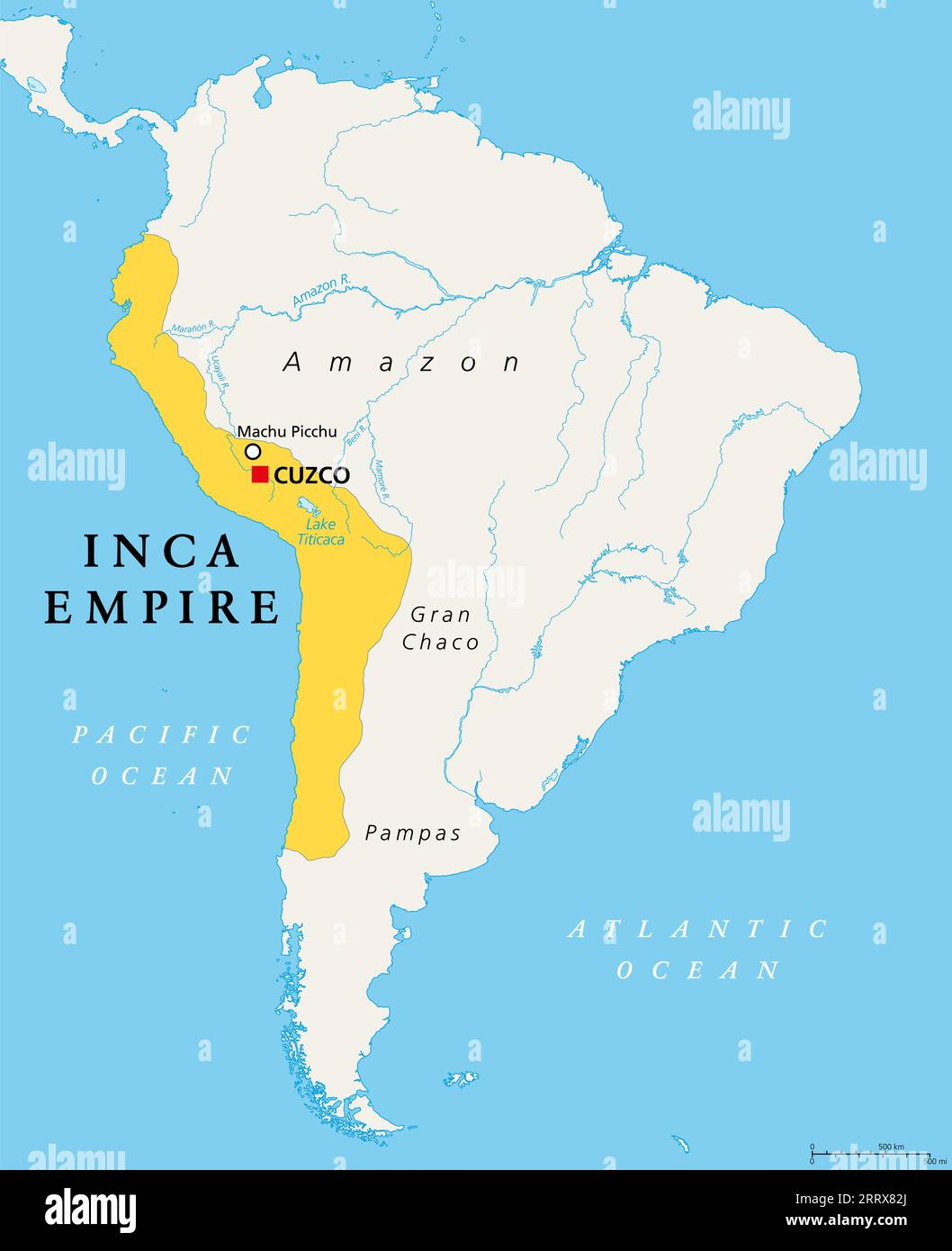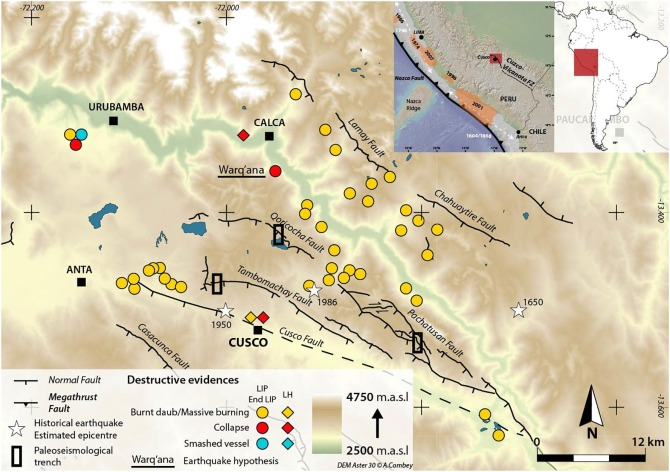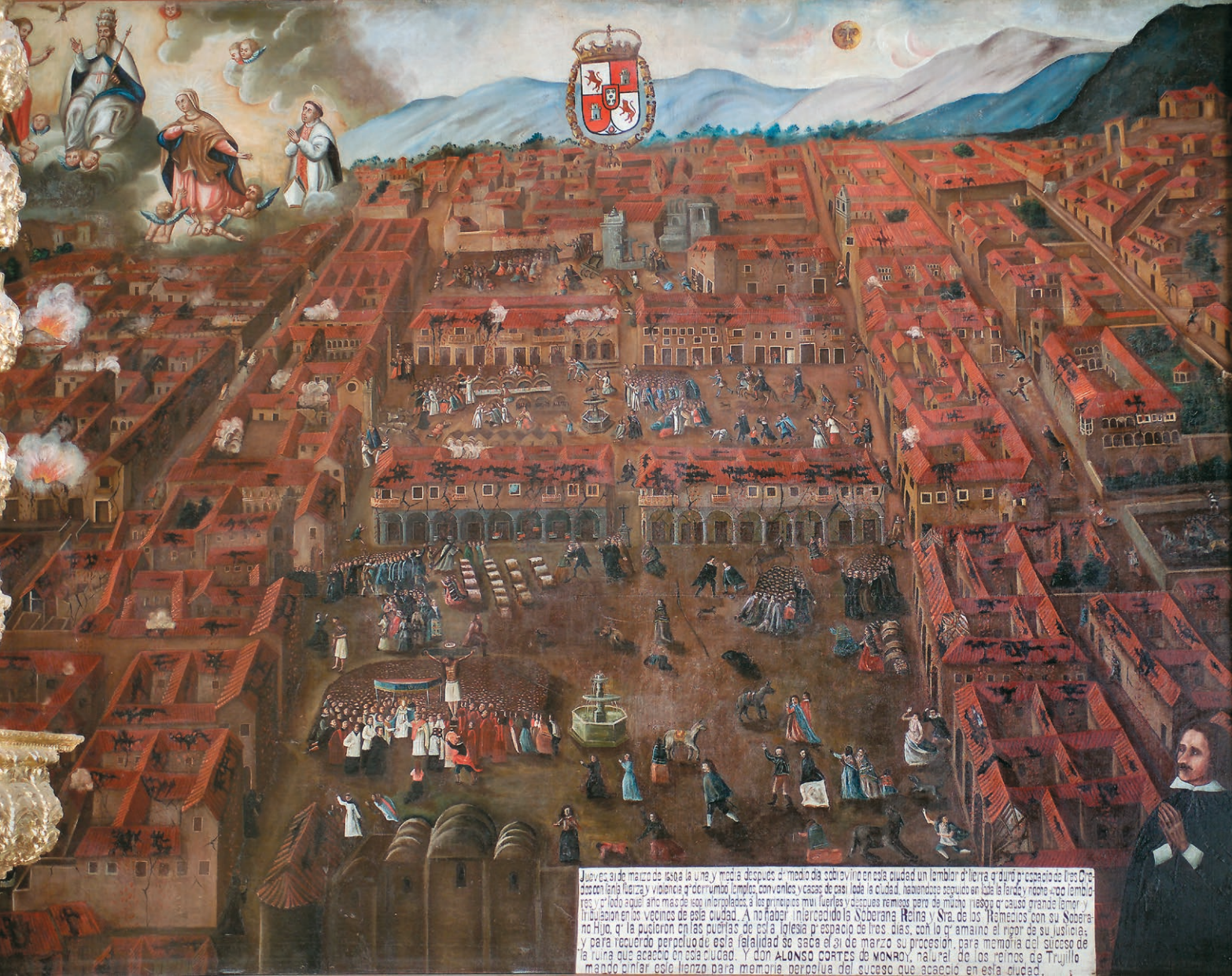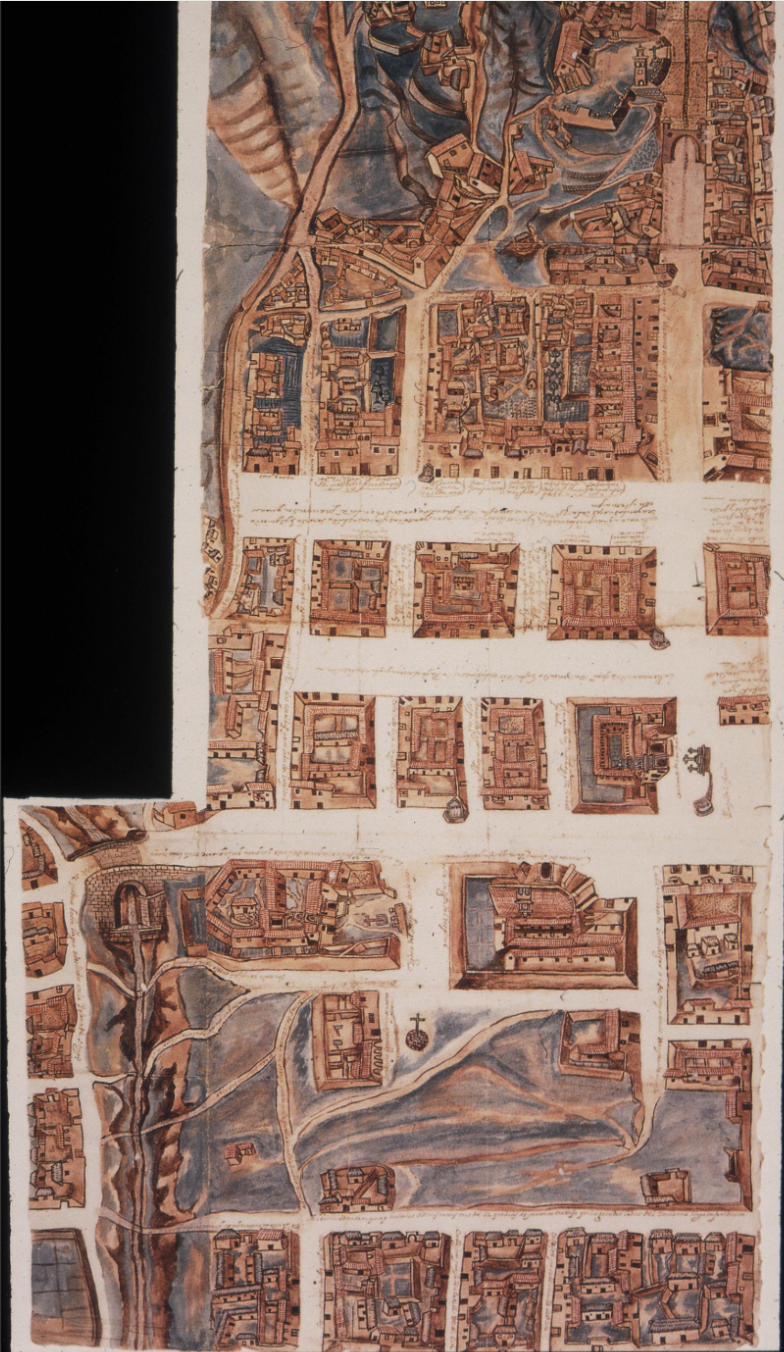It is March 31st, 1650 when tragedy overfalls the city. An extremely powerful earthquake strikes the city at 2:00 in the afternoon. Churches, homes, and buildings crumble, leaving the citizens in ruins and dust. Many try to save artwork and religious artifacts, some are successful while others are not. This story takes place in 1600’s Cusco, Peru. Cusco is the former capital of the Inca Empire, which fell out of power due to the Spanish conquest in the 1500s. It is located high in the Andes Mountains.
It is important to set the scene, as this earthquake not only physically destroyed the city but also had religious and societal impacts. As said before, Cusco was the heart of the Inca Empire, which was ruled by South American Natives. According to Britannica, the Incan Empire“extended from the Pacific coast and Andean highlands from the northern border of modern Ecuador to the Maule River in central Chile.” (See figure 1) According to Cusco by Mark Cartwright, the city was built in the form of a puma and was dominated by fine buildings and palaces including gold-covered and emerald-studded temples. The city flourished with art, religion, and architecture. The city had a population of around 40,000 with another 200,000 in the surrounding area (Cusco, Mark Cartwright). Cusco was honored by the Inca subjects as a sacred site. Soon, however, Spanish conquistadors changed the trajectory of the Empire. In 1532, Spanish soldiers led by Francisco Pizarro, overthrew the Inca leader Atahualpa and conquered Peru (History Crunch). Due to previous European travelers who had brought diseases to South America, the Inca Empire was weakened, giving the Spanish an advantage. The takeover resulted in the Spanish forcefully changing and controlling the fallen Empire. The Spanish completely changed the system of rule in order to try and keep the Inca out of power(Lumenlearning). In addition, the Spanish changed systems of agriculture, which had been finely honed by the Incas over years of time. Heavy manual labor taxes were forced upon the Inca, which was called “mita” (Lumenlearning). Overall the Spanish forced their culture, economic, and political policies onto the Inca and held power over them.
Figure 1: Features a map showing the Inca Empire and Cusco.
Figure 2: Evidence of destructive events based on archeological discoveries including the collapse of buildings as well as other archeological artifacts.
Despite the magnitude of destruction of the earthquake, the amount of casualties was fortunately quite minimal. “Structural survey and Empirical Seismic vulnerability assessment of dwellings in the historical Centre of Cusco, Peru” (Brando 2019) determined that the earthquake caused extensive damage, which spread to neighboring towns and was felt as far as Lima, Peru. From a geographical standpoint, the magnitude of the earthquake on a Richter scale was above 7 MM, similar to the more recent earthquakes that occurred in 1950 and 1986. The cause for earthquakes has to do with two important concepts that include the shifting of tectonic plates and fault line boundaries. Tectonic plates are large sections of the Earth’s crust that float on the semi-fluid asthenosphere, and fault lines are the boundaries and gaps where these plates meet. When friction and pressure is caused by the movement of these massive sections via sliding, they begin to collide, or move away from one another along the fault lines. This is what leads to the phenomena of earthquakes. According to the figure shown above (Figure 2), it can be observed that Cusco sits directly on the Cusco fault line and is also very close to the Tambomachay fault line (approximately 4 km). Oftentimes if one fault line is triggered causing a high enough magnitude earthquake, a fault line nearby can also cause another earthquake at a lesser magnitude which occurred in this case.
Furthermore, the earth earthquake not only destroyed the land but had lasting effects on religious circumstances. It crumbled various Inca temples and sacred locations. The Catholic church took advantage of this by aiding the recovery with their practices. It is also important to highlight the fact that it is human nature to seek answers and reasons as to why bad things happen, especially in regards to religion. In the case of the earthquake, religious authorities in Cusco interpreted the catastrophe in their own Catholic perspective which left a lasting influence on the natives, among others, “in which the cataclysmic results seemed to explode straight from the Bible” (In 1650, a massive earthquake hit Cuzco…). With destruction everywhere people turned and the wish to seek for answers increasing as a result of this devastating event, it made it much more feasible for the religious authorities to swoop in as a beacon of hope and slowly transform ideologies from one to the next. It was also very common back then for people to connect such disasters to religion rather than science to explain what was going on with the world. When people have their religion to look at when disasters happen it gives them a sense of comfort and the fact that after this catastrophe, the Catholics saw that people were having doubts about their religion and decided to swoop in and spread their ideas connecting the earthquake to the Bible, leading many to change religions and follow their Catholic ways.
Encomiendas served as the lifeblood that sustained the Spanish colonization of Latin America. These grants, approved and enforced by viceroys to the Spanish king, entitled colonists to indigenous land and labor. Indentured servitude of the indigenous peoples and enslaved African peoples allowed the Spanish conquistadors to gut the original structures of Cusco and distort them to serve colonial demands. Catholic churches were built by enslaved Africans and Cuscueños in the skeletons of Cusco’s religious buildings. At the time of the earthquake, the malignant changes of colonial influence were well underway, transforming many of the “undesirable” traditional aspects of the grand city to more closely fit Spanish ideals. The Spanish sought to commandeer the city of Cusco into a Spanish colonialist utopia, but progress towards this end was slow and intensive. The 1650 earthquake thus provided an unprecedented opportunity for the Spanish colonists, as the widespread devastation of native and Spanish buildings alike meant that rebuilding the city would no longer be impeded by the preexisting city, but could be built anew in a pure, Spanish image. Similarly, this pressing need for reconstruction efforts could cement colonial control over and subjugation of indentured servants. In a letter to the Spanish king following the earthquake, Spanish colonists made an explicit request to extend their encomiendas, tightening their grip over the lives of the enslaved peoples, but also extending the terms of their servitude over additional generations. The Spanish colonists suffered as a result of this unprecedented earthquake but saw it as a prime opportunity to erase what little of the indigenous culture remained, and to build back in a more pure Spanish vision.
The artwork that emerged after the earthquake represents Spain’s impact on the town’s reconstruction, religion, and art style to fit their ideal standards as mentioned in the previous paragraph. For example, the Andean baroque style (see Figure 5) combines Christian and indigenous symbols (Hajovsky 2018). The colonization of Cusco can be seen in the artwork of religious paintings, European architecture, and city layout.
Figure 3: (Hajovsky 2018): This painting by an unknown artist shows the town of Cusco during the 1650 earthquake. Many of the Spanish settlers flocked to the town center where their religious building was and surrounded the sculpture of Santo Cristo (Holy Christ), as it was taken out of the church and paraded and placed into the center of the town. 
In the top left corner of the painting is a Marian apparition, a symbol in the Catholic religion where it represents the intervention of a divine power that can provide medical healing, messages, etc (Otto 1985). In this instance, the Marian apparition showcased a light to stop the earthquake, which is why many of the Spanish settlers surrounded the Santo Cristo. This would later become a symbol in Peru of a figure that can stop earthquakes called the Nuestro Señor de los Temblores (Our Lord of the Earthquakes) (Tripoli 2017). However, the religious symbols in the painting were painted to rejustify the reconstruction of the indigenous building of Cusco to their Spanish image and the forcing of Catholicism onto the Cusco people as the earthquake ruined much of their native architecture.
The painting also shows a dominant perspective of the Incas religious and social culture but has been changed to showcase more Spanish architecture (Hajovsky 2018). An example of this change is the way the buildings are set up in a gridlike pattern and the construction of new buildings to fit their European ideals (Hajovsky 2018). The symbols of Catholic saints, and angels, in the sky show that the Spanish thought it was their Catholic right to conquer Cusco and to change the buildings, culture, and religion of the indigenous people. This was a “manifest destiny” mindset that the Spanish church and state had when they conquered not just Cusco but many other Latin American countries (Eckler 2020). This painting depicts how Spanish settlers thought this earthquake was something that their gods and Catholicism gave to change Cusco into their European ideals and forcibly spread their faith with the creation of Temblores that “stopped the earthquake” and protected them from it (Max 2010). Furthermore, the creation of the Temblores was done by the Spanish to appeal more to the Cusco people and have them be converted to their religion through this manipulation.

Figure 4: (Leibsohn, Mundy 2015): Map painting of Cusco by an unknown artist. It was made in 1643 before the earthquake. In the map, the bottom and middle center of the map show a cross, religious buildings, and the houses are also in a gridlike pattern. This style represents the Spanish settlers’ ideals of what they wanted Cusco to look like. The upper portion of the map has more mountains and rivers, with many of the buildings clustered together, signifying what Cusco looked like when inhabited by the indigenous people.

Figure 5: (University of Arkansas 2017): A religious building of the Andean baroque style. Andean baroque is an architectural style that mixes Catholicism from Spain and Cusco religion and culture. For example, they replaced the door handles with animals used in Andean imagery (University of Arkansas 2017). This hybrid art style shows how Catholic colonialism is slowly turning Andean symbolism into that of Catholicism.
In the aftermath of the 1650 earthquake that devastated Cusco, Peru, the city stood amid destruction. After the shaking stopped, the Spanish settlers saw a chance for social reconstruction and a way to reshape Cusco in the image they wanted. As a result of this, the native culture drastically changed in many ways. The art at the time also shows a mix of Christian and native contributions that depict the clash of cultures and the emphasis on segregation nurtured and influenced by conquistadors. So why does this matter? The Cusco earthquake was much more than just an earthquake. It destroyed art and religious items while also proving how intensely colonization has affected ancient civilization. This can be parallelized to N.K. Jemisin’s Broken Earth Trilogy, where during the Syl Anagist chapters, we repeatedly see how Hoa’s race was used for torturous labor like the encomiendas. In the book, Hoa finds out what the briar patch really is, a place where his race gets the life and magic sucked out of them, however, they’re still alive in order to keep making this magic to keep the obelisk alive. These obelisks are used by Syl Anagist to keep the city alive, with their slogan of “Life is sacred in Syl Anagist,”. This can be seen with the encomiendas in Cusco since Spain forcefully made them do labor to turn their city to their European ideals. Another connection between the book and Cusco, was when Keleni took Hoa and his friends on a tour of their origin and they saw how they were able to use magic for art and culture. This is similar to Cusco before they were colonized by Spain, where the city was rich in indigenous art and culture. However, later in the book the readers find out that when Syl Anagist came over and conquered them, they used their ideas of how they harnessed magic to create what their city is now, however since they couldn’t do it like them, they used those people to build it, by once again using their life and magic. This connects to Cusco, because after the earthquake Spanish settlers in Cusco tried to further enslave the encomiendas to rebuild the city in their Spain ideal image, and when this did happen, many paintings and Andean baroque architecture emerged, however, much of the indigenous material and symbolism remains in such art. For example, old indigenous buildings in Cusco still remain today, becoming a tourist attraction, just like how Keleni gave Hoa and his friends a tour of the old society. In conclusion, N.K. Jemisin’s Broken Earth Trilogy connects to Cusco’s history of colonization where both Hoa’s kind and Cusco people were used and abused by those who conquered them.
Bibliography:
“Encomenderos in Cuzco Petition the King after the Great Earthquake of 1650.” Vistas.ace.fordham.edu, vistas.ace.fordham.edu/lib/17th/encomenderos/. Accessed 24 Apr. 2024.
Hajovsky, Patrick Thomas. “Shifting Panoramas: Contested Visions of Cuzco’s 1650 Earthquake.” The Art Bulletin, vol. 100, no. 4, 2 Oct. 2018, pp. 34–61, https://doi.org/10.1080/00043079.2018.1464358. Accessed 15 June 2022.
“The Spanish Conquest | World Civilization.” Courses.lumenlearning.com, courses.lumenlearning.com/suny-hccc-worldcivilization/chapter/the-spanish-conquest/#:~:text=Diseases%20that%20the%20population%20had.
“Map of Cuzco · VistasGallery.” Vistasgallery.ace.fordham.edu, vistasgallery.ace.fordham.edu/items/show/1779. Accessed 24 Apr. 2024.
Publicación Especial N ° 14 -Resúmenes Ampliados Del XIX Congreso.
Brando, Giuseppe & Cocco, Giulia & Mazzanti, Claudio & Peruch, Matteo & Spacone, Enrico & Alfaro, Crayla & Sovero, Simone & Tarque, Nicola. (2019). Structural Survey and Empirical Seismic Vulnerability Assessment of Dwellings in the Historical Centre of Cusco, Peru. International Journal of Architectural Heritage. 15. 1-29. 10.1080/15583058.2019.1685022.
Eckler, Camden. The Roots of Exploitation and Inequality in Latin America, 2020, scholar.utc.edu/cgi/viewcontent.cgi?article=1289&context=honors-theses.
Max. “Black Jesus.” Wayne To The Max, 14 Dec. 2010, waynetothemax.wordpress.com/2010/12/14/black-jesus/.
“A New World Take on the Baroque.” Honors College Blog, University of Arkansas, 2017, honorsblog.uark.edu/a-new-world-take-on-the-baroque/.
Otto. “Dictionary of Mary.” Catholic Book Publishing, 1985, catholicbookpublishing.com/products/dictionary-of-mary-full-color.
Tripoli. “A Lesson in Colonialism at Cusco Cathedral.” BashfulAdventurer.Com, 16 Jan. 2017, bashfuladventurer.com/lesson-colonialism-cusco-cathedral/.
